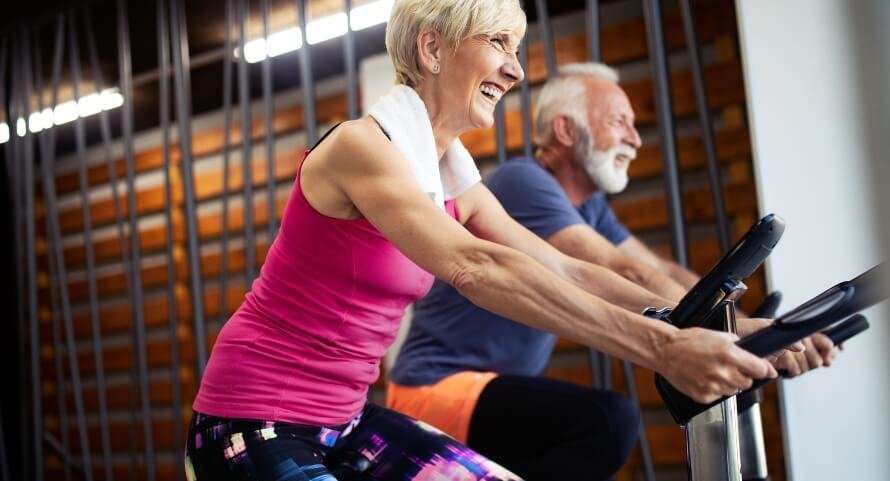[ad_1]
A “low-impact workout” is a workout that includes only joint-friendly exercises.
They’re beneficial because they give everyone—including the elderly, unfit, and injured—the opportunity to exercise safely without pain or discomfort.
If you’re interested in low-impact exercise but aren’t sure what constitutes a low-impact exercise or which low-impact exercises are effective, this is the article for you.
In it, you’ll learn what low-impact workouts are, why they’re beneficial, the different types of low-impact workouts, the best low-impact strength training workouts and low-impact cardio workouts you can do, and more.
What Does “Low-Impact Workout” Mean?
You can split most exercises into two categories: high-impact exercises and low-impact exercises.
High-impact exercises involve jumping, landing, or jerking movements that “impact” your bones, joints, and connective tissues, such as jogging, box jumps, and plyometric push-ups.
In contrast, low-impact exercises typically involve smooth or flowing movements that don’t jolt your skeletal system, such as walking, swimming, and regular push-ups.
Thus, a low-impact workout is a workout that includes only low-impact exercises.
The Benefits of Low-Impact Exercise
The primary benefit of low-impact exercise is that it’s easier on your bones, joints, and connective tissues than regular exercise.
This means it’s an excellent way to train if you’re older, have impaired skeletal health (osteoarthritis or osteoporosis, for example), or have existing injuries that make high-impact exercise uncomfortable. It’s also a good option if you’re out-of-shape and want a smooth on-ramp into training.
The only compromise is that low-impact exercise is often slightly less effective than high-impact exercise for losing weight and gaining strength and muscle (unfortunately, some of the most effective exercises put pressure on your joints).
That said, you can still reach your health and fitness goals using low-impact exercise; it just may take a little longer than if you trained unrestricted.
Types of Low-Impact Workouts
There are two types of low-impact workouts: low-impact weight training workouts and low-impact cardio workouts. Here’s what you need to know about each.
Low-Impact Strength Training Workouts
Low-impact strength training workouts involve weightlifting exercises that are kind to your joints.
Few upper-body strength training exercises involve jarring movements, so most are suitable for inclusion in a low-impact workout. That said, some upper-body exercises are “gentler” on your joints than others, so you should prioritize these exercises.
For instance, dumbbell and machine exercises are generally more suitable for low-impact workouts than barbell exercises.
That’s because dumbbells allow your limbs to move more freely than barbells, enabling you to alter your movements to avoid pain, and machine exercises don’t require as much stability as free-weight exercises, which takes some of the pressure off achy joints.
Conversely, several lower-body weightlifting exercises (variations of the lunge and step-up, for example) involve stepping while holding extra weight.
This puts more pressure on your joints than exercises where your feet remain rooted to the floor throughout. Thus, it’s best to omit these exercises from your low-impact workouts.
Low-Impact Cardio Workouts
Low-impact cardio workouts come in two varieties: low-impact HIIT workouts and low-impact moderate-intensity cardio workouts.
During a low-impact HIIT workout, you perform a low-impact form of cardio and alternate between periods of (almost) all-out intensity and low-intensity recovery. The best low-impact exercise machines to use in your low-impact HIIT workouts are:
- Elliptical machine
- Rowing Machine
- Stationary bike (recumbent and upright)
- SkiErg
Low-impact moderate-intensity cardio is any low-impact aerobic exercise performed at a steady pace, typically for an extended period. The best forms of low-impact moderate-intensity cardio are:
The Best Low-Impact Strength Training Plans
Before we get into the best low-impact strength training plans, let’s review a couple of points about the exercises you’ll be doing.
Both of the plans below include the deadlift, which many assume is a high-impact exercise because it’s associated with heavy weightlifting. However, this isn’t necessarily so.
Despite allowing you to lift heavy weights, the deadlift doesn’t involve moving any of your joints through a long range of motion, which means it doesn’t stress your joints the way many fear. For example, it doesn’t require you to bend your knees much, which means it’s usually well-tolerated in people who suffer knee pain.
As such, deadlifting is a reasonable exercise selection in a low-impact strength training plan.
That said, some people find the deadlift aggravates their lower back, especially if they have past lower-back injuries. If that’s the case for you, swap it for a similar exercise that places less stress on your spine, such as the sumo or trap-bar deadlift or barbell or cable row.
Barbell squatting is also conspicuously missing from the programs, an oddity given how effective the squat is at helping you gain muscle and strength across most of your body.
It’s absent because many people find front and back squatting beats up their wrists, elbows, shoulders, knees, and lower back, especially if their mobility is lacking.
As a workaround, the plans include the Bulgarian split squat instead, which trains the same muscles, requires you to use less weight, and places significantly less stress on your knees.
With that said, here are the workouts.
3-Day Low-Impact Push Pull Legs Workout Plan
The gist of a “push pull legs (PPL) workout plan is simple: you do exercises that train your pushing (chest, triceps, shoulders), pulling (back and biceps), and leg muscles in separate workouts each week.
For best results, leave at least one day between each workout (you could train on Monday, Wednesday, and Friday, for example).
Low-Impact Pull Workout
Low-Impact Push Workout
Low-Impact Leg Workout
2-Day Low-Impact Full-Body Workout Plan
This 2-day low-impact full-body workout plan is ideal for people who want to spend minimal time in the gym and still gain muscle and strength.
To allow yourself time to recover, allow at least 2 days between each workout. For example, if you do Workout #1 on Monday, wait until Thursday to do Workout #2.
Low-Impact Full-Body Workout #1
- Deadlift: 3 sets of 8-to-10 reps with 2-to-3 min rest
- Flat Dumbbell Bench Press: 3 sets of 8-to-10 reps with 2-to-3 min rest
- Leg Press: 3 sets of 8-to-10 reps with 2-to-3 min rest
- Lat Pulldown: 3 sets of 8-to-10 reps with 2-to-3 min rest
Low-Impact Full-Body Workout #2
- Bulgarian Split Squat: 3 sets of 8-to-10 reps with 2-to-3 min rest
- Incline Dumbbell Bench Press: 3 sets of 8-to-10 reps with 2-to-3 min rest
- One-Arm Dumbbell Row: 3 sets of 8-to-10 reps with 2-to-3 min rest
- Shoulder Press: 3 sets of 8-to-10 reps with 2-to-3 min rest
And if you like the look of these workouts and want even more options specifically designed to help absolute beginners at any age and fitness level get in the best shape of their life, check out my fitness book for men and women, Muscle for Life.
(Or if you aren’t sure if Muscle for Life is right for you or if another strength training program might be a better fit for your circumstances and goals, take Legion Strength Training Quiz, and in less than a minute, you’ll know the perfect strength training program for you. Click here to check it out.)
The Best Low-Impact Cardio Workouts
Before each of these high-intensity workouts, it’s best to warm up by doing 5-to-10 minutes of the same exercise at a low-intensity. You don’t need to warm up before the moderate intensity workout.
High-Intensity Low-Impact Workout #1
Here’s a simple 10-minute low-impact workout you can do on any low-impact exercise equipment, such as an elliptical machine, rowing machine, stationary bike, or SkiErg:
- Do a 20-second sprint at about 90% of your max effort, followed by 40 seconds of low-intensity recovery.
- Repeat 10 times for a total of 10 minutes of exercise (not including a warm up)
High-Intensity Low-Impact Workout #2
Here’s a more challenging high-intensity low-impact cardio workout to try once the above workout becomes too easy. Again, use any low-impact exercise equipment you like:
- Do a 60-second sprint at about 90% of your max effort, followed by 60 seconds of low-intensity recovery.
- Repeat 10 times for a total of 20 minutes of exercise.
Moderate-Intensity Low-Impact Workout
Spend 30-to-60 minutes doing low-impact exercise that you enjoy, like walking, swimming, cycling, or rucking.
FAQ #1: What’s the best low-impact workout at home?
Here’s a low-impact bodyweight workout you can do 1-to-3 times per week at home without equipment:
- Bodyweight Bulgarian Split Squat: 3 sets of 10-to-20 reps with 2-to-3 min rest
- Push-up: 3 sets of 10-to-20 reps with 2-to-3 min rest
- Bodyweight Inverted Row: 3 sets of 10-to-20 reps with 2-to-3 min rest
If you’d also like to do a low-impact at-home cardio workout, go for a 30-to-60-minute walk 1-to-3 times weekly.
And if you want even more advice about the best workouts to do at home, check out this article:
The Best Home Workout Routines for When You Can’t Go to the Gym
FAQ #2: What is a low-impact workout for beginners?
The 2-Day Low-Impact Full-Body Workout Plan above is an excellent low-impact beginner workout for those new to strength training.
When it comes to cardio, you don’t need to do anything complicated; the best low-impact cardio workout for beginners is walking 1-to-3 times weekly for 30-to-60 minutes per workout.
FAQ #3: Can you do a low-impact ab workout?
If you follow a low-impact strength training plan like those above, there’s no reason to do a low-impact ab workout. That’s because many of the weightlifting exercises you’re already doing train your abs to a high degree.
If you’re not doing low-impact strength training but want to do exercises specifically for your abs that won’t put stress on your bones and joints, check out the advice in this article:
How to Actually Get Six Pack Abs
FAQ #4: What are the best low-impact exercise machines?
Here’s the best low-impact exercise equipment for training each body part:
- Chest: The chest press machine, seated dip machine, and cable machine (for the cable fly).
- Shoulders: The shoulder press machine, lateral raise machine, and reverse fly machine
- Back: The lat pulldown, seated row machine, and assisted pull-up machine.
- Arms: Biceps curl machine, triceps extension machine, and cable machine (for the cable biceps curl and triceps pushdown).
- Legs: The leg press, hack squat machine, and leg curl machine.
FAQ #5: What is the best low-impact exercise for seniors?
Seniors should do a mix of low-impact strength training and cardio each week.
Here’s a good low-impact workout for seniors:
- Bodyweight squat: 3 sets of 5-to-10 reps (or more) with 3 min rest
- Wall Push-up: 3 sets of 5-to-10+ reps with 3 min rest
- Glute Bridge: 3 sets of 5-to-10+ reps with 3 min rest
- Banded Row: 3 sets of 5-to-10+ reps with 3 min rest
When it comes to cardio, you don’t need to do anything complicated; the best low-impact cardio workout for seniors is walking 1-to-3 times weekly for 20-to-40 minutes per workout.
+ Scientific References
- Jones, M. T., Ambegaonkar, J. P., Nindl, B. C., Smith, J. A., & Headley, S. A. (2012). Effects of unilateral and bilateral lower-body heavy resistance exercise on muscle activity and testosterone responses. Journal of Strength and Conditioning Research, 26(4), 1094–1100. https://doi.org/10.1519/JSC.0B013E318248AB3B
- Schilling, B. K., Cantrell, G. S., & DeFOREST, B. A. (n.d.). Muscle Activity in Single- vs. Double-Leg Squats – PubMed. Retrieved April 24, 2023, from https://pubmed.ncbi.nlm.nih.gov/27182408/
- Mackey, E. R., & Riemann, B. L. (2021). Biomechanical Differences Between the Bulgarian Split-Squat and Back Squat. International Journal of Exercise Science, 14(1), 533. /pmc/articles/PMC8136570/
[ad_2]
Source link



